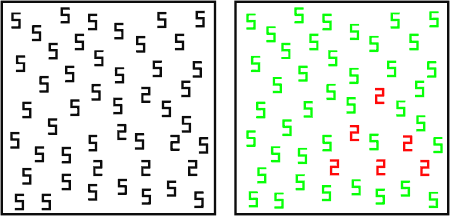Synesthesia
Cross-wiring of the Senses

Kiki-Bouba Test

Some skeptics have dismissed synesthesia as nothing more than subjective invention, like a bad case of metaphor affliction - after all, anyone can feel blue, see red, eat a sharp cheese or wear a loud tie. Recently, however, a group of neuroscientists have been able to prove that synaesthetes do indeed "see" sound. Other tests have been created to localize and differentiate between the different categories of synesthesia.
Testing for Synesthesia
Look at the image on the left. How quickly can you find all the two's? For normal individuals it takes around 20-30 seconds but for people with grapheme synesthesia it only takes about three.
To them, the fives and the twos appear as separate colors making it much easier to tell the difference. For normal people it is difficult to distinguish between them because the two numbers look so similar.
This test is a simple and classic example used to identify different types of synesthesia.
Which of the two figures above would you label Kiki, which would you label Bouba? 95% of participants said the figure on the left should be named Bouba and the one on the right Kiki.
The rounded shape may most commonly be named "bouba" because the mouth makes a more rounded shape to produce that sound while a more taut, angular mouth shape is needed to make the sound "kiki". The sounds of a K are harder and more forceful than those of a B, as well.
This effect suggests that the human brain is somehow able to extract abstract properties from the shapes and sounds. There is a connection to areas of the brain that is similar to the way cross wiring works in synesthesia.
In recent years brain imaging techniques have allowed for a greater understanding of how synesthesia works no a neurological level. By mapping out areas of the brain that become active during different tests researchers are able to clearly see which areas are 'cross-wired'.
Some skeptics believed that synesthesia was like a placebo-effect. However, this idea was proven wrong when a group of grapheme synesthetes were tested. They were blind folded and read different passages of text. The imaging showed that even when not looking at the text areas of the brain that deal with color were activated.
This experiment and many others like it proved that synesthesia was indeed a real phenomenon.
Auditory tests entail listening to multiple sounds to see if any elicit strange feelings or sensations. Some might experience a taste in their mouth while others see colorful shapes. The results vary depending on the individual and the type of synesthesia involved.
Retesting is often conducted with auditory tests. For example, an individual is asked to listen to a set of sounds. After each sound they are asked to assign a specific color or taste to it. After a certain amount of time, they are given the same sounds again and asked to do the same task. A synesthete will be able to assign the same characteristics very easily, since they experience neural associations which are automatic and consistent.

MRI and Brain Imaging

Neurological Auditory Tests
Number Search